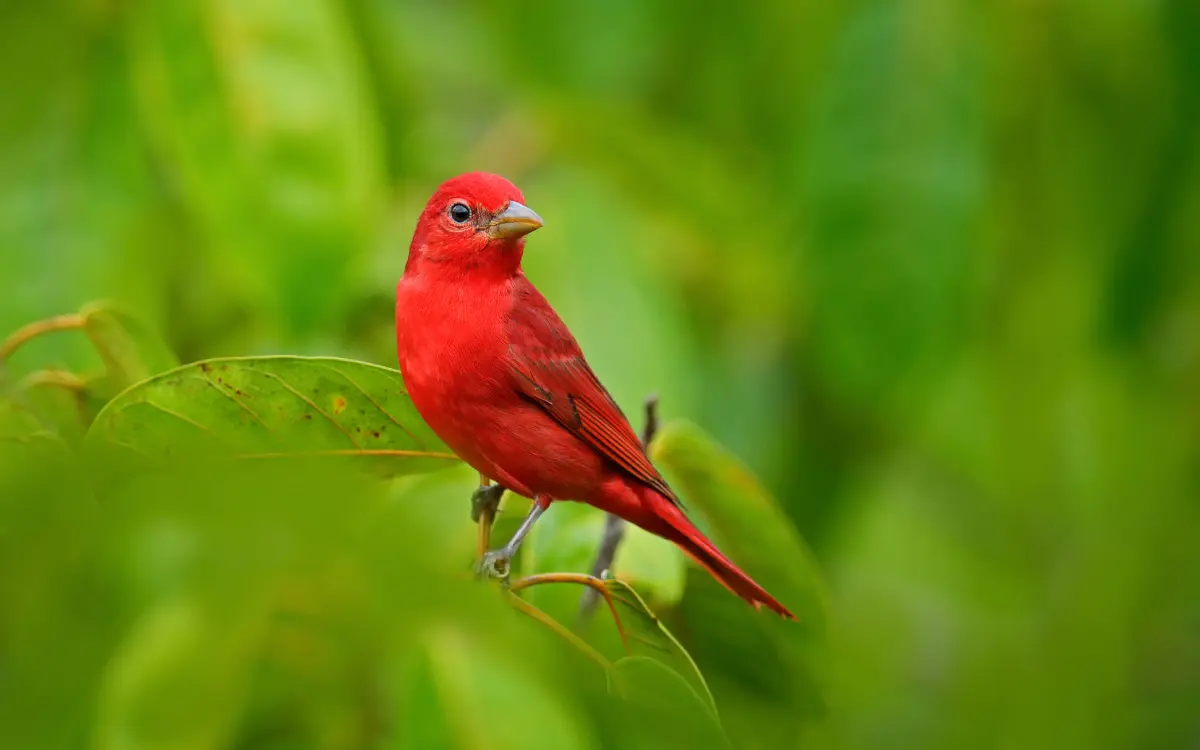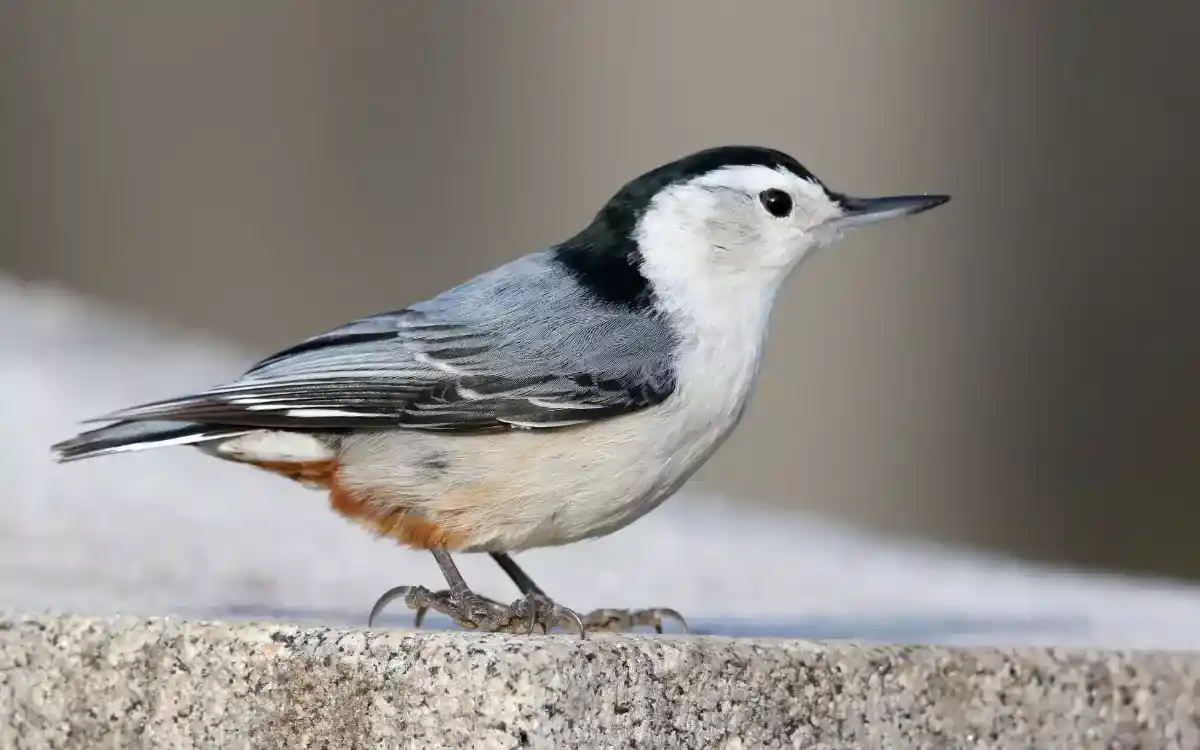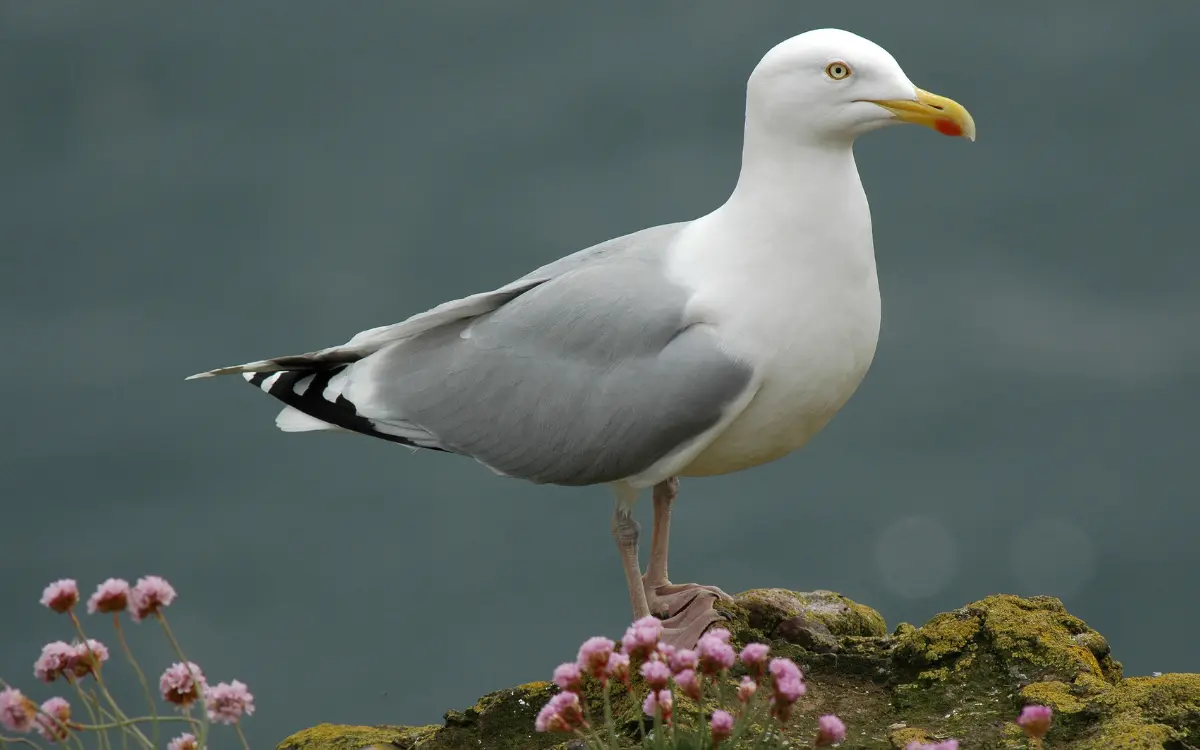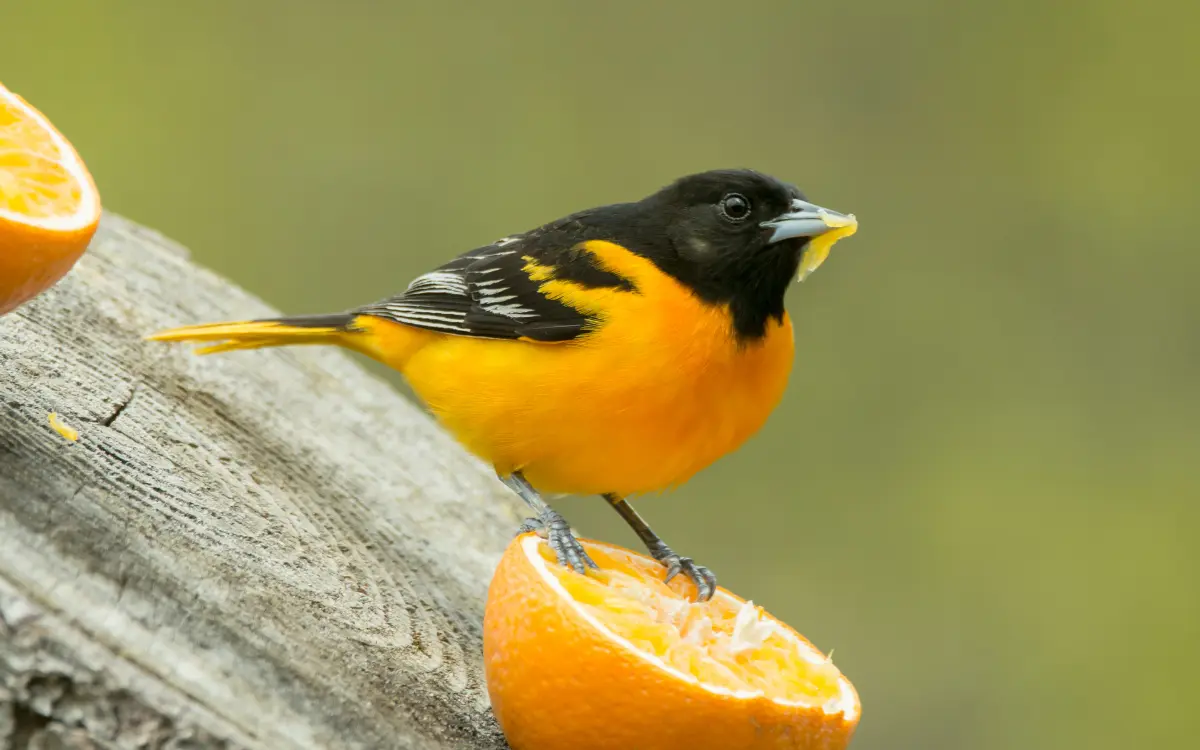41 Species of Ducks Found in Texas (ID &Calls)
Texas is one of the best places in the U.S. to see ducks. With over 41 different species showing up across the state, there’s always something interesting to spot whether it’s a colorful Wood Duck in a forest pond or a big flock of Snow Geese flying over a field. This guide covers 41 ducks and duck-like birds you can find in Texas. You’ll learn what they look like, where to see them, what sounds they make, and when they show up. If you enjoy birdwatching, or just want to know more about the ducks near you, this list is a great place to start.
List of 41 Species of Ducks Found in Texas:
1. Northern Pintail (Anas acuta):
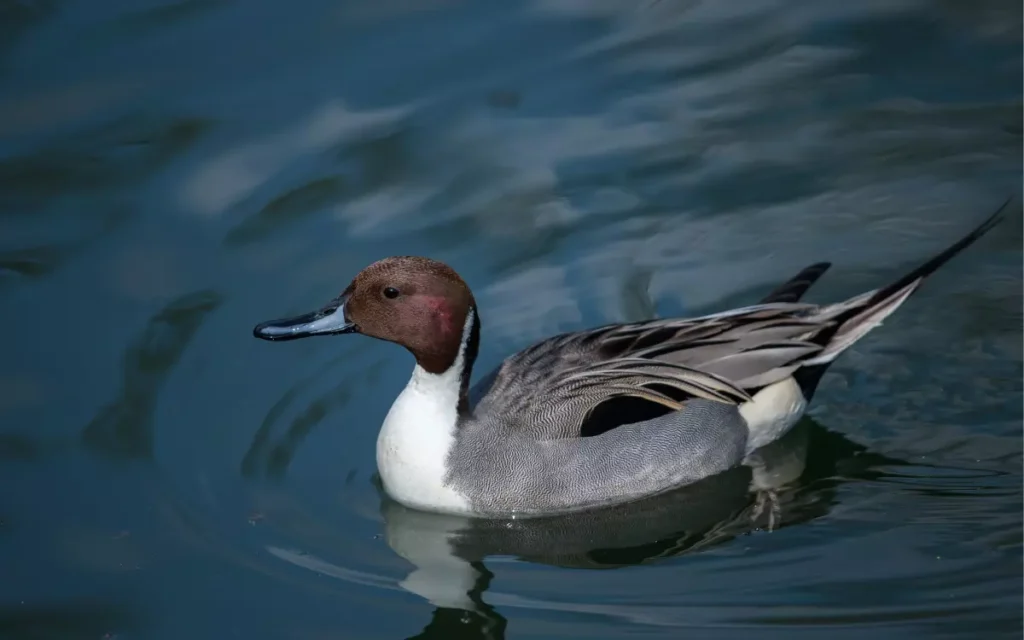
Graceful and streamlined, the Northern Pintail is easily identified by its long, pointed tail feathers and slender neck. Males show off a crisp white chest, chocolate-brown head, and a glossy green speculum on their wings. Females are more subdued in brown but equally elegant in shape.
These ducks are winter visitors in Texas and often feed in shallow ponds, flooded fields, and marshes. Watch for their swift, direct flight patterns and listen for their soft whistles during migration.
- Habitat: Coastal marshes, prairie wetlands, flooded fields
- Nesting: Ground nests near shallow water
- Eggs: 6–12 per clutch
- Wingspan: 29 – 35 in (74 – 89 cm)
- Length: 20 – 26 in (51 – 66 cm)
- Weight: 36.3 oz (1030 g)
Call:-
Male
Female
2. Eurasian Teal (Anas crecca):

Also known as the Common Teal, the Eurasian Teal is a rare but possible winter visitor to Texas. Males are small and colorful, with chestnut heads and a striking green eye patch, while females are speckled brown with a small, compact build.
These dabbling ducks prefer shallow wetlands and feed on seeds and aquatic invertebrates. Their high-pitched whistling calls are often heard before they’re seen.
- Habitat: Wetlands, marshes, shallow lakes
- Nesting: Ground nests in dense grass (mainly in Europe/Asia)
- Eggs: 5–16 per clutch
- Wingspan: 53–59 cm
- Length: 13–17 in (34–43 cm)
- Weight: 11–13 oz
3. Wood Duck (Aix sponsa):

The Wood Duck is one of the most stunning waterfowl species in Texas. Males are known for their iridescent green, purple, and chestnut plumage, while females have a soft gray-brown body with a white teardrop eye-ring.
Unlike most ducks, they nest in tree cavities, even high above ground or water. You’ll often see them in wooded swamps and quiet ponds. Their gentle whistling and soft squeaks are easy to recognize once you hear them.
- Habitat: Wooded wetlands, forested ponds, swampy backwaters
- Nesting: In natural cavities or nest boxes
- Eggs: 7–15 per clutch
- Wingspan: 26.0 – 28.7 in (66 – 73 cm)
- Length: 18.5 – 21.3 in (47 – 54 cm)
- Weight: 16.0 – 30.4 oz (454 – 862 g)
Wood Duck call:-
Male
Female
4. Mottled Duck (Anas fulvigula):

A true Texan resident, the Mottled Duck lives along the Gulf Coast all year. Its overall brown and buff coloring makes it easy to overlook, but its loyalty to marsh habitats and subtle quacks give it away.
Unlike many migratory ducks, this species stays put in coastal estuaries and marshes. It feeds on aquatic vegetation and invertebrates, often seen cruising through calm backwaters.
- Habitat: Coastal marshes, estuaries, rice fields
- Nesting: Ground nests hidden in tall grasses
- Eggs: 8–12 per clutch
- Wingspan: 95.7–106.3 cm (37.7–41.8 in)
- Length: ~21 in
- Weight: ~2.25 lbs
5. American Wigeon (Anas americana):
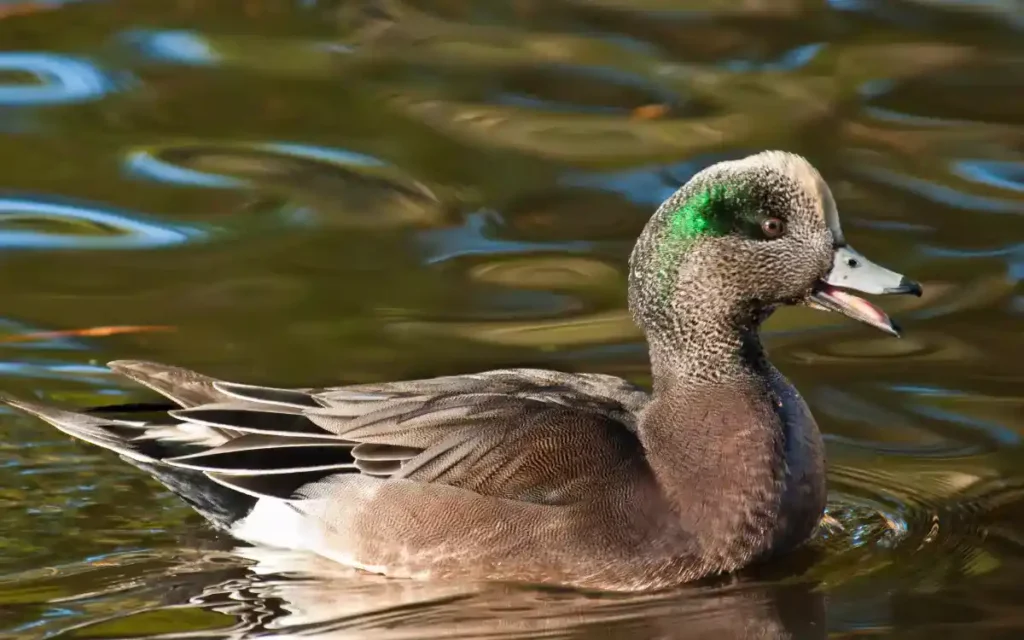
Nicknamed the “baldpate” for its white forehead, the American Wigeon is a compact duck with a soft pinkish-brown body and iridescent green streak behind the eye. Its whistling “whew-whew-whew” call is one of the most distinctive among dabblers.
You’ll find wigeons grazing in shallow wetlands or grassy edges during the winter months in Texas. They’re often seen in mixed flocks with other dabblers.
- Habitat: Shallow ponds, marshes, lakes
- Nesting: Ground nests in grasses (mostly outside Texas)
- Eggs: 6–11 per clutch
- Wingspan: 33.1 in (84 cm)
- Length: 16.5 – 23.2 in (42 – 59 cm)
- Weight: 19.1 – 46.9 oz (540 – 1330 g)
Call:-
Male
Female
6. Mallard (Anas platyrhynchos):
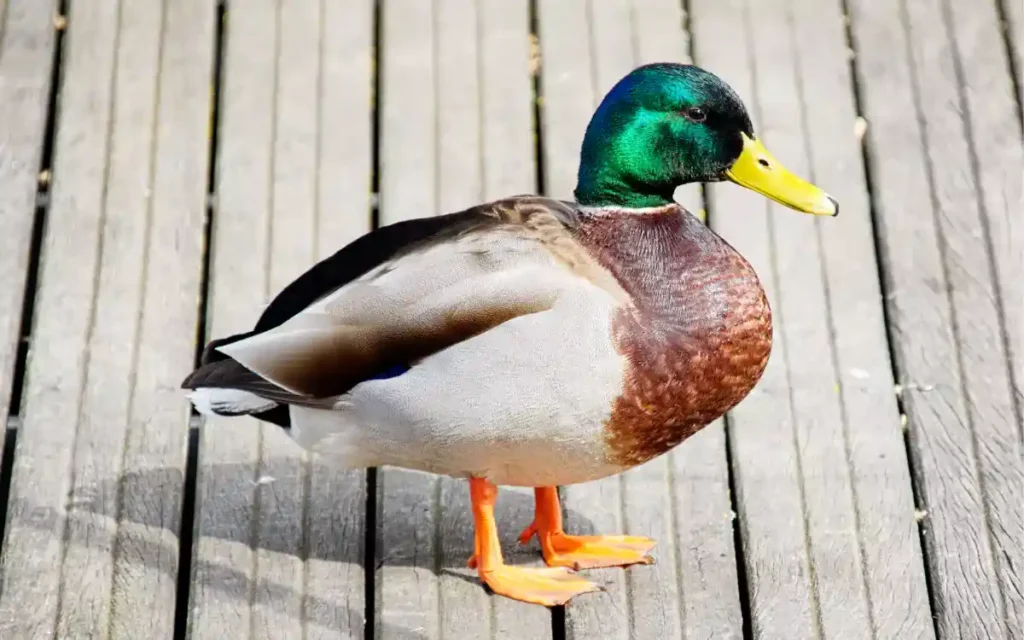
Mallards are the most recognizable ducks in North America and are found year-round across Texas. The male’s shiny green head, yellow bill, and white neck ring are unmistakable, while females are speckled brown with a distinct orange-and-black bill.
Mallards adapt to all kinds of freshwater environments—from rural ponds to city parks. Their loud quacking and social behavior make them favorites among birdwatchers and casual observers alike.
- Habitat: Lakes, ponds, wetlands, city parks
- Nesting: Ground nests near water in dense vegetation
- Eggs: 8–12 per clutch
- Wingspan: 2.7 – 3.2 ft
- Length: 20 – 28 in
- Weight: 1.5 – 3.5 lbs (0.7–1.6 kg)
Call:-
Male
Female
7. Bufflehead (Bucephala albeola):
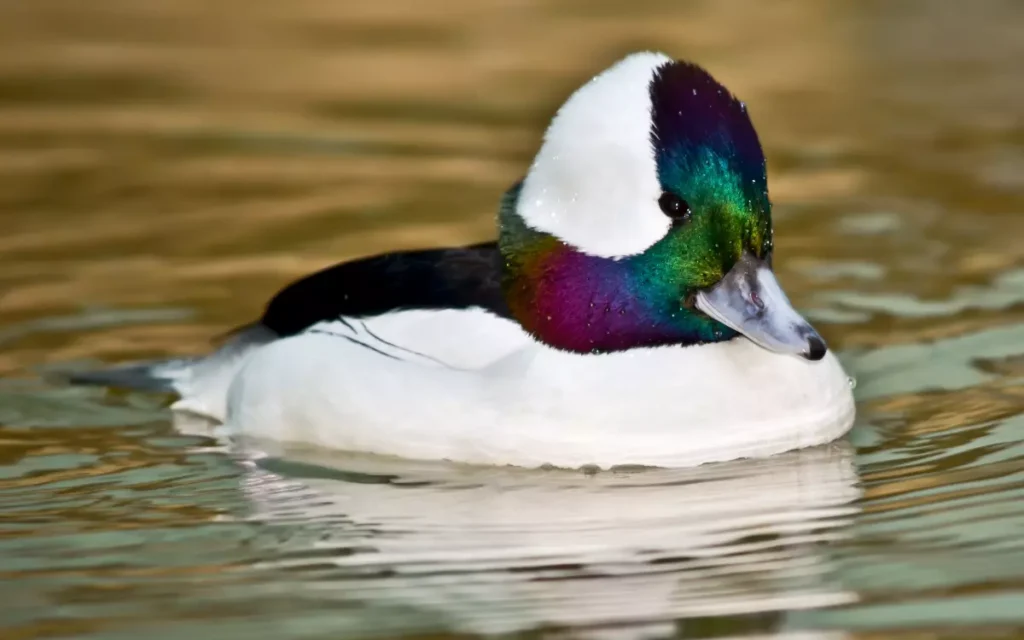
Buffleheads are striking winter visitors in Texas, best recognized by the male’s black-and-white plumage and large puffy head. Their small size and fast wingbeats make them a delight to watch as they dive for food in open water.
These ducks often nest in tree cavities up north but spend their winters in Texas lakes and coastal lagoons. Listen for their high-pitched squeaks and whistles while they forage in pairs or small groups.
- Habitat: Lakes, bays, estuaries
- Nesting: Tree cavities (mostly outside Texas)
- Eggs: 6–11 per clutch
- Wingspan: 21.6 in (55 cm)
- Length: 13 – 16 in
- Weight: ~1 lb (0.45 kg)
Call:-
Male
Female
8. Gadwall (Anas strepera):
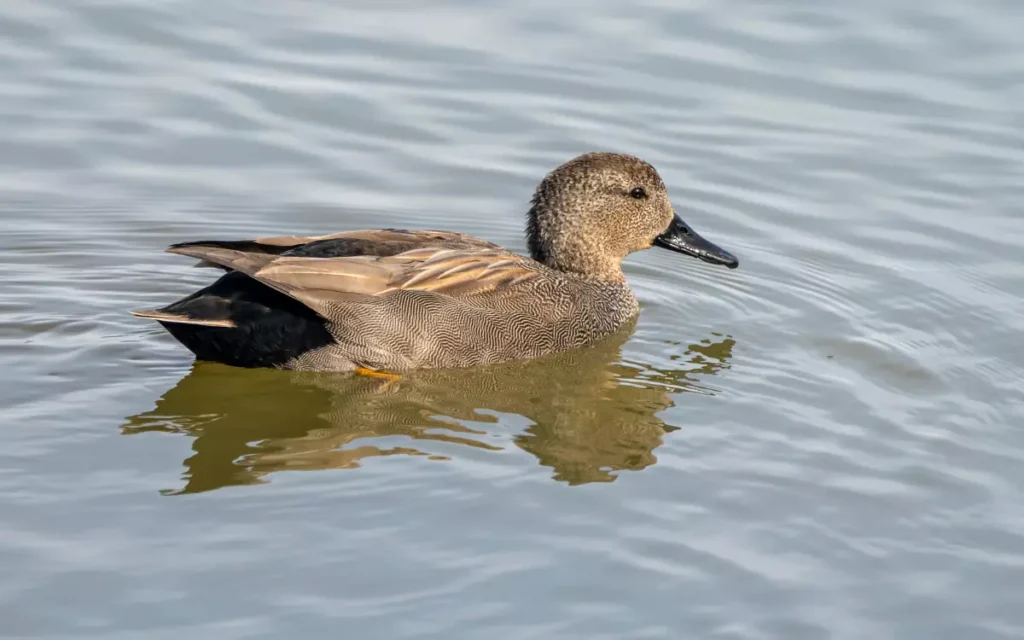
Gadwalls may appear plain at first glance, but their soft gray-brown tones and understated elegance make them easy to appreciate. Males have a black rump and white wing patch visible in flight, while females look similar to mallards but with thinner, darker bills.
These ducks are common in Texas wetlands during winter, quietly dabbling for submerged plants. Their loud, nasal quacks are surprisingly noticeable despite their muted looks.
- Habitat: Lakes, marshes, reservoirs
- Nesting: Ground nests hidden in vegetation
- Eggs: 8–13 per clutch
- Wingspan: 31–33 in (78–85 cm)
- Length: 18 – 22 in
- Weight: 1.1 – 2.3 lbs
Call:-
Male
Female
9. Green-winged Teal (Anas crecca):
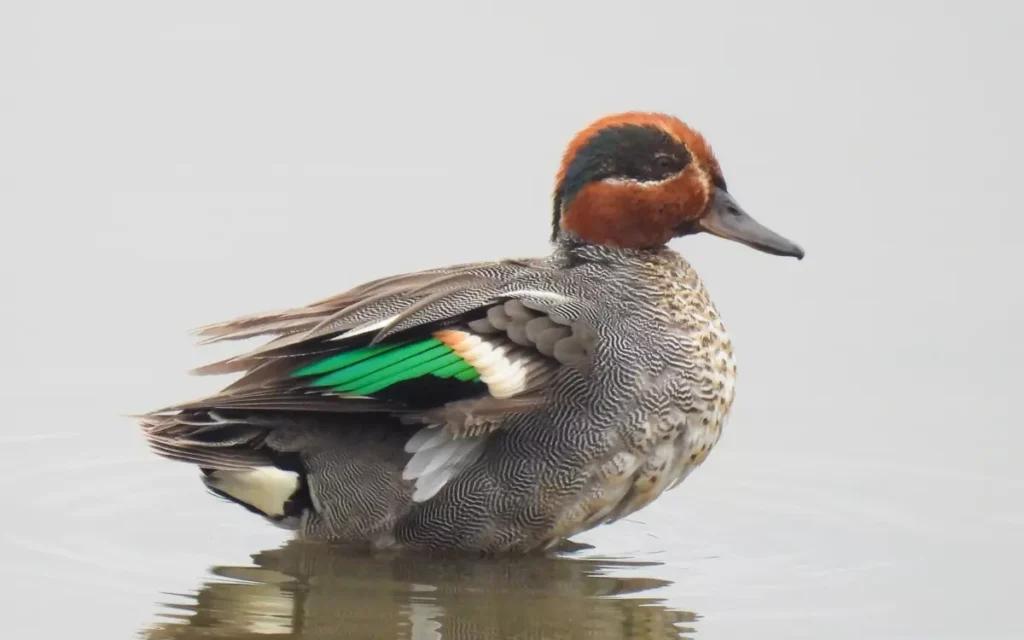
Small, fast, and beautiful in flight, the Green-winged Teal is a favorite among duck watchers. Males have a chestnut head with a shimmering green eye patch, while females are intricately speckled brown.
They often forage in shallow ponds, feeding in tight flocks during migration and winter. Despite their size, their high-pitched whistling calls can carry across wetland areas.
- Habitat: Shallow marshes, flooded fields
- Nesting: On the ground, usually in grass near water
- Eggs: 6–10 per clutch
- Wingspan: 102–122.5 cm
- Length: 20.5 – 23 in
- Weight: 1100 – 1400 g
Call:-
Male
Female
10. Black-bellied Whistling Duck (Dendrocygna autumnalis):

Unlike most ducks, the Black-bellied Whistling Duck stands tall on long legs and often perches in trees. With chestnut sides, a gray face, and—of course—a black belly, they’re unmistakable. Their whistling calls sound almost human.
These social, year-round residents are often found in groups near ponds and flooded fields. They’re one of the few duck species where both sexes share nesting duties.
- Habitat: Marshes, ponds, flooded fields, park wetlands
- Nesting: Tree cavities or nest boxes
- Eggs: 8–18 per clutch
- Wingspan: 37 in
- Length: 19 in
- Weight: 1.7 lbs
Call:-
Male
Female
11. Ruddy Duck (Oxyura jamaicensis):
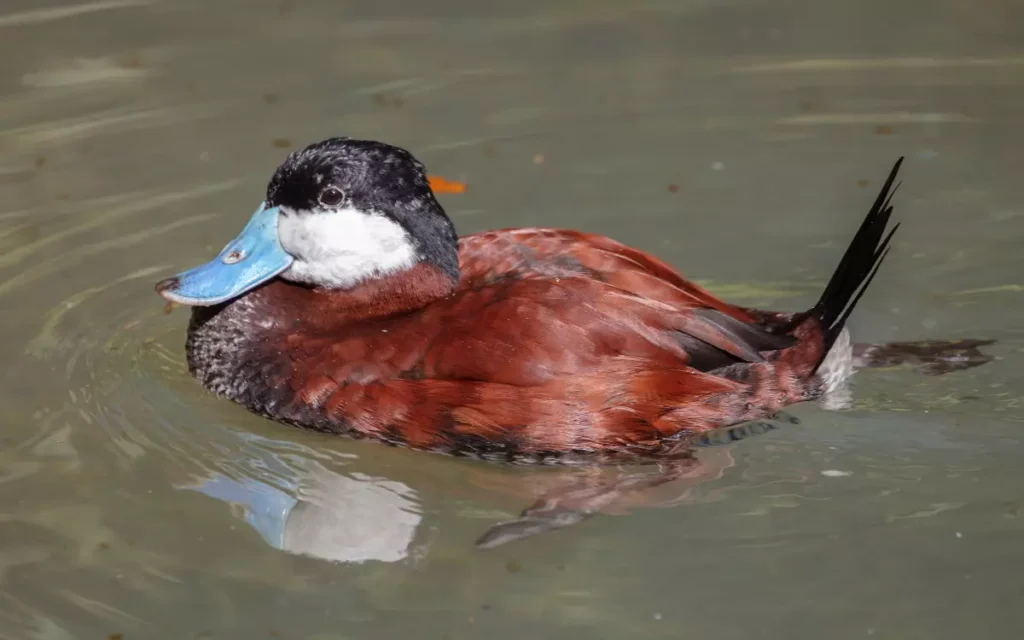
Small but full of personality, the Ruddy Duck is best known for the male’s bright blue bill and stiff tail, which it often cocks upward like a wren. During the breeding season, males also take on rich chestnut coloring, though winter males and females are more muted.
They’re excellent divers and feed on aquatic invertebrates. In Texas, they’re most commonly seen in winter on calm lakes and ponds.
- Habitat: Lakes, ponds, reservoirs
- Nesting: Floating vegetation or marsh edges (mainly outside TX)
- Eggs: 6–10 per clutch
- Wingspan: 23 in
- Length: 14 – 17 in
- Weight: 0.68 – 1.8 lbs
Call:-
Male
Female
12. Redhead (Aythya americana):

With its rich cinnamon-red head, gray back, and black chest, the male Redhead is a striking diving duck. Females are more modestly colored in soft brown, but both sexes are easy to spot on open water due to their smooth, low-floating posture.
Redheads are common winter migrants in Texas and often seen in large flocks, especially along the coast.
- Habitat: Lakes, bays, marshes
- Nesting: Over water in dense vegetation (mostly northern range)
- Eggs: 8–14 per clutch
- Wingspan: 33 in (84 cm)
- Length: 18 – 22 in
- Weight: 2.0 – 2.5 lbs
Call:-
Male
Female
13. Canvasback (Aythya valisineria):
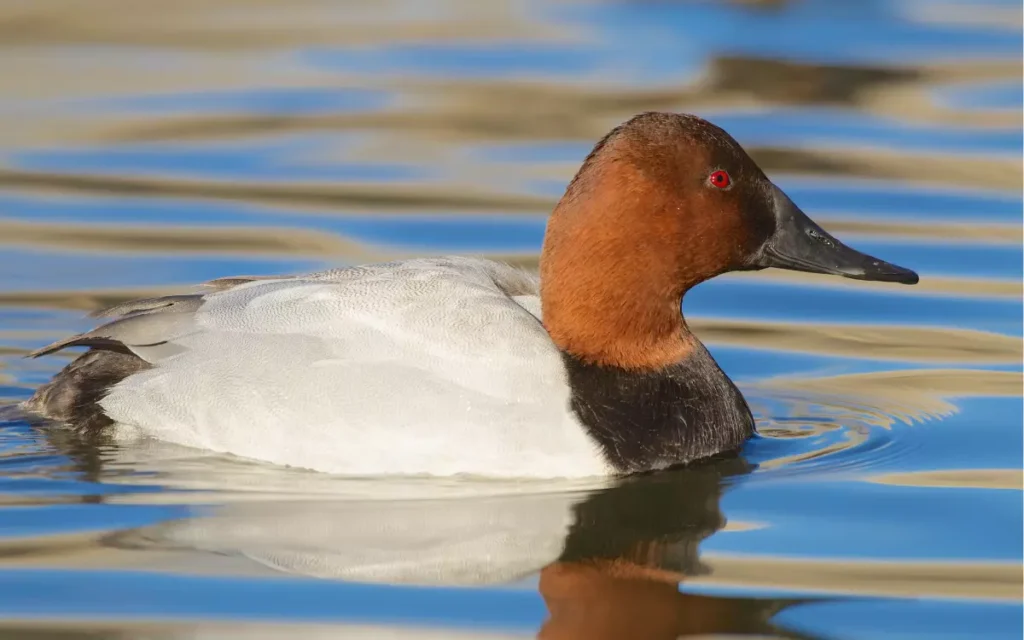
Often called the “aristocrat of ducks,” the Canvasback has a sleek, sloped forehead and brilliant red eyes. Males are bright white with black chests and rufous heads, while females are tan with a similar silhouette.
As diving ducks, they forage underwater for plant tubers and mollusks. Canvasbacks winter in large numbers on Texas coastal bays and deeper lakes.
- Habitat: Coastal bays, lakes, reservoirs
- Nesting: Floating vegetation beds in northern wetlands
- Eggs: 6–10 per clutch
- Wingspan: 34 in
- Length: 19 – 22 in
- Weight: 1.9 – 3.5 lbs
14. Lesser Scaup (Aythya affinis):

Lesser Scaups are diving ducks with gray bodies, black heads, and blue bills. Males have a subtle purplish iridescence on their heads, while females are brown with a white patch near the bill. They are often confused with the similar Greater Scaup, but are more common inland.
Seen throughout Texas during winter, these ducks forage in lakes and coastal areas, often in large mixed flocks.
- Habitat: Lakes, coastal bays, reservoirs
- Nesting: Ground nests near northern freshwater marshes
- Eggs: 8–12 per clutch
- Wingspan: 27–30 in
- Length: 15 – 18 in
- Weight: ~1.8 lbs
Call:-
Male
Female
15. Fulvous Whistling Duck (Dendrocygna bicolor):

With its rich cinnamon color and long legs, the Fulvous Whistling Duck stands out from typical ducks. Its call is a high-pitched whistle, giving the species its name. Often seen in pairs or small flocks, these ducks are most active around dawn and dusk.
They forage in rice fields and marshes, using their long necks to reach aquatic vegetation below the surface.
- Habitat: Rice fields, freshwater marshes
- Nesting: On the ground, often among grasses
- Eggs: 8–12 per clutch
- Wingspan: 18–21 in
- Length: 18–21 in
- Weight: ~1.6 lbs
16. Cinnamon Teal (Spatula cyanoptera):

The Cinnamon Teal’s name says it all — males display vivid reddish-brown plumage that sets them apart from any other duck. Females are mottled brown and resemble Blue-winged Teals but are slightly bulkier.
These dabbling ducks are rare in Texas, typically seen during migration in shallow wetlands. Their calls are soft and musical, and they’re usually quiet unless alarmed.
- Habitat: Shallow ponds, marshes, flooded fields
- Nesting: Ground nests in grasses or reeds
- Eggs: 6–15 per clutch
- Wingspan: 21.3–22.4 in (54–57 cm)
- Length: ~16 in
- Weight: 13–14 oz
Call:-
Male
Female
17. Northern Shoveler (Spatula clypeata):

Easily identified by its oversized, spoon-shaped bill, the Northern Shoveler is a quirky and active dabbling duck. Males have bold green heads, white chests, and rusty flanks, while females are mottled brown with large orange bills.
They use their bills like sieves, filtering tiny invertebrates from shallow water. Common in Texas during winter, they often feed in spinning groups that stir up food.
- Habitat: Shallow wetlands, ponds, flooded fields
- Nesting: Ground nests in grassy cover
- Eggs: 9–11 per clutch
- Wingspan: ~31 in
- Length: ~19 in (48 c
Call:-
Male
Female
18. Ring-necked Duck (Aythya collaris):

Despite its name, the Ring-necked Duck rarely shows its namesake ring. Instead, look for the male’s black back, gray sides, and white ring on the bill. Females are a soft brown with a distinct eye ring and plain bill.
They’re diving ducks often seen in small groups during winter in Texas. Their subtle calls include soft whistles and raspy notes.
- Habitat: Lakes, reservoirs, marshes
- Nesting: Vegetation near water (mostly north of Texas)
- Eggs: 8–10 per clutch
- Wingspan: 24.4–24.8 in (62–63 cm)
- Length: 15 – 18 in
- Weight: ~1.6 lbs
Call:-
Male
Female
19. Hooded Merganser (Lophodytes cucullatus):

One of the most elegant winter visitors to Texas, the Hooded Merganser features a fan-like crest that males can raise or lower. Males are black and white with golden eyes, while females are brown with a cinnamon crest.
These small fish-eating diving ducks prefer wooded ponds and quiet rivers. You’re more likely to hear their frog-like croaks or breathy hoots than a typical duck quack.
- Habitat: Forested lakes, rivers, ponds
- Nesting: In tree cavities
- Eggs: 7–12 per clutch
- Wingspan: ~26 in
- Length: 16 – 19 in
- Weight: 1.2 – 1.5 lbs
Call:-
Male
Female
20. Common Merganser (Mergus merganser):
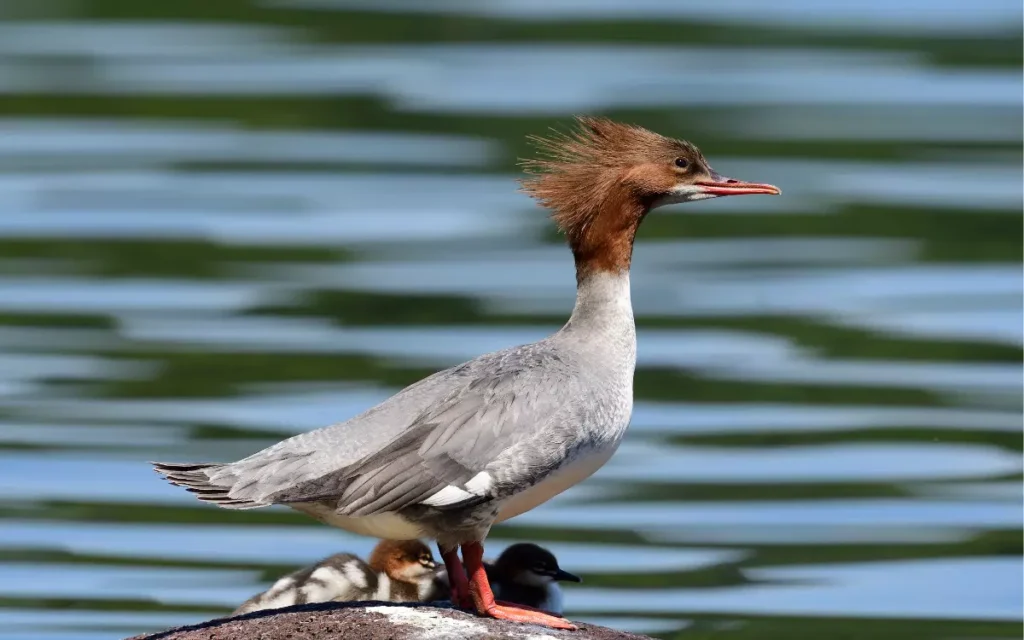
The Common Merganser is a sleek, fish-eating duck with a sharp, saw-like bill. Males are bright white with green-black heads, while females sport shaggy crests and gray bodies with cinnamon heads.
They’re rare in Texas but can appear on large lakes and rivers in winter. Their croaking calls are low and coarse, unlike the whistles and quacks of dabblers.
- Habitat: Deep rivers, large reservoirs, lakes
- Nesting: In tree cavities near water
- Eggs: 6–12 per clutch
- Wingspan: ~37 in
- Length: 1.7 – 2.3 ft
- Weight: ~3.2 lbs
Call:-
Male
Female
Read also:-
21. Muscovy Duck (Cairina moschata):
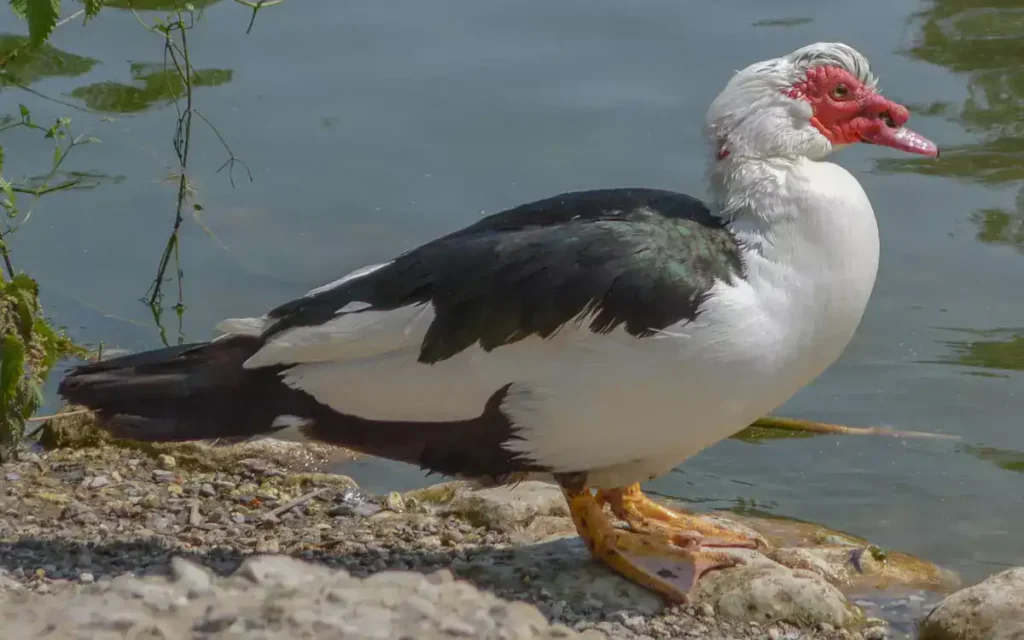
The Muscovy Duck is hard to miss. With its large body, red facial caruncles, and quiet hissing calls, it stands apart from other ducks. Native to Central and South America, it now thrives in both rural and urban parts of Texas.
Unlike quacking ducks, Muscovies are mostly silent. They forage on land or water, often seen waddling near ponds, ditches, and even suburban lawns.
- Habitat: Urban ponds, farms, wetlands, drainage canals
- Nesting: Tree cavities, underbrush, man-made structures
- Eggs: 8–16 per clutch
- Wingspan: 4.5 – 5 ft
- Length: 2.5 ft
- Weight: 4.6–6.8 kg (10–15 lbs)
22. Greater Scaup (Aythya marila):
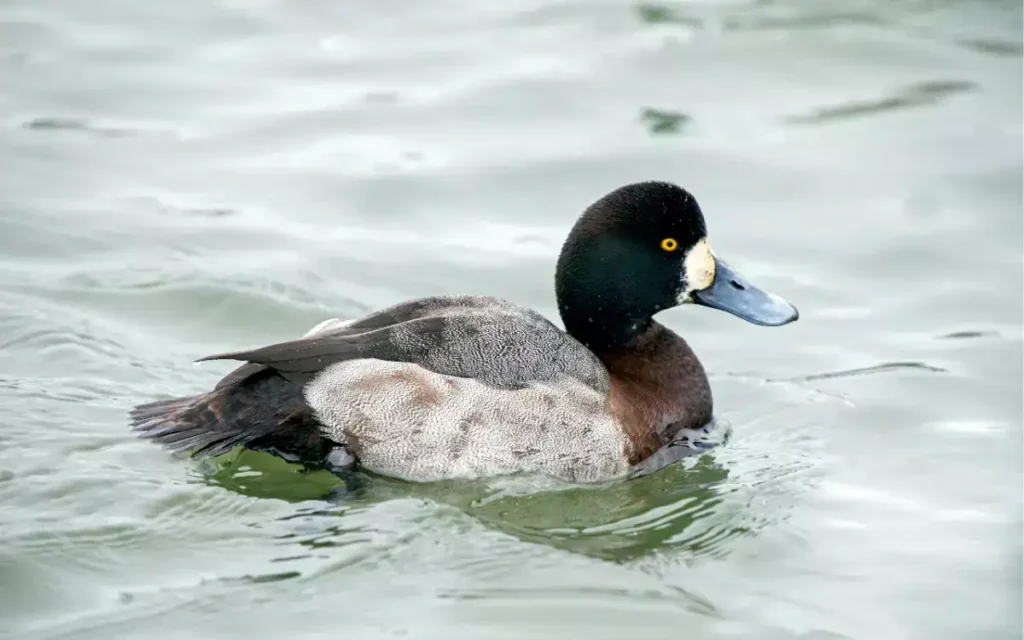
Often confused with the Lesser Scaup, the Greater Scaup is a slightly larger diving duck with a rounded head and bold black-and-white contrast. Males are crisp and clean in plumage, while females feature a white patch near the bill.
They’re rare winter visitors in Texas, usually spotted in large, open bodies of water. Their grunting and whistling sounds blend into mixed flocks with other scaup and diving ducks.
- Habitat: Coastal waters, large lakes
- Nesting: Tundra wetlands in summer (outside Texas)
- Eggs: ~9 per clutch
- Wingspan: 28–33 in (71–84 cm)
- Length: 15–22 in
- Weight: ~2 lbs
23. Blue-winged Teal (Spatula discors):

The Blue-winged Teal is one of the first ducks to arrive in Texas during spring migration. Males are elegant with a crescent moon on their faces and blue shoulder patches; females are brown and often seen in small groups.
They prefer shallow, weedy wetlands and are known for their quick, darting flight. Their soft whistling calls are best heard during early morning feeding sessions.
- Habitat: Shallow ponds, flooded fields, wetlands
- Nesting: Ground nests hidden in grass
- Eggs: 6–14 per clutch
- Wingspan: 56–62 cm
- Length: 16 in (40 cm)
- Weight: 10–18 oz
Call:-
Male
Female
24. Common Goldeneye (Bucephala clangula):

The Common Goldeneye is a striking diving duck with a glossy green-black head and bright yellow eyes. Males show a white cheek patch, while females are brown-headed with duller plumage.
These ducks are uncommon in Texas but may appear on lakes and reservoirs in winter. Their rapid wingbeats and whistling flight sound are unique among diving ducks.
- Habitat: Deep freshwater lakes and rivers
- Nesting: Tree cavities (in northern breeding areas)
- Eggs: 4–12 per clutch
- Wingspan: 31 in
- Length: 16–20 in
- Weight: ~2 lbs
Call:-
Male
Female
25. Red-breasted Merganser (Mergus serrator):
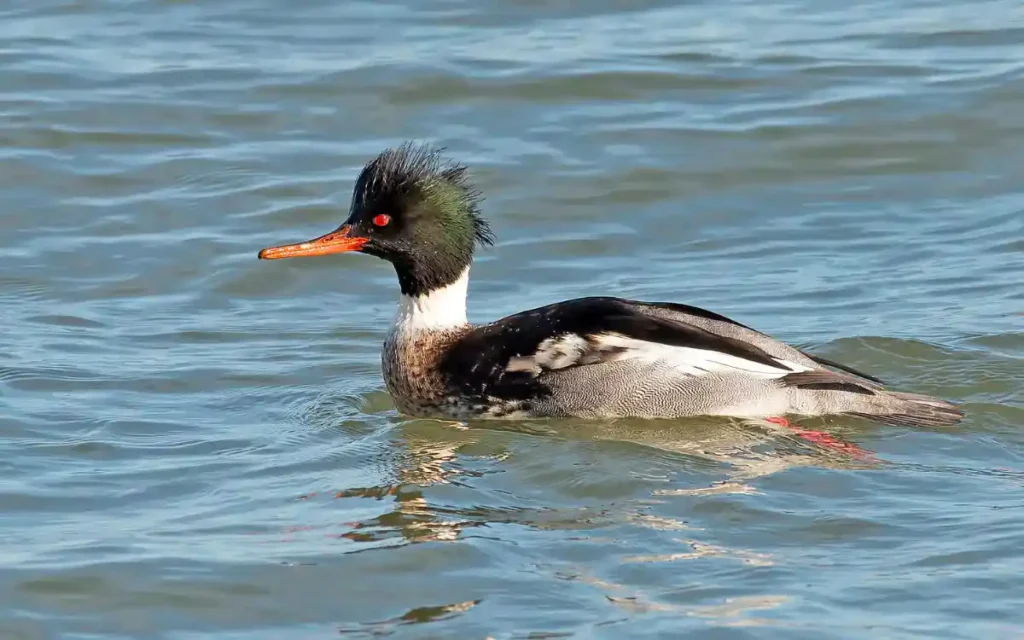
Known for its ragged crest and long, skinny bill, the Red-breasted Merganser is a sleek diving duck built for chasing fish. Males have rusty necks and dark green heads, while females are grayish-brown with reddish crests.
These are rare but exciting winter visitors to Texas, often seen on coastal bays and large inland lakes. Their croaks and hoarse calls sound more like seabirds than typical ducks.
- Habitat: Coastal waters, large freshwater lakes
- Nesting: Ground or hollowed depressions near water
- Eggs: 3–24 per clutch
- Wingspan: 26–29 in
- Length: 1.7 – 2.1 ft
- Weight: ~2.3 lbs
Call:-
Male
Female
26. Mexican Duck (Anas diazi):
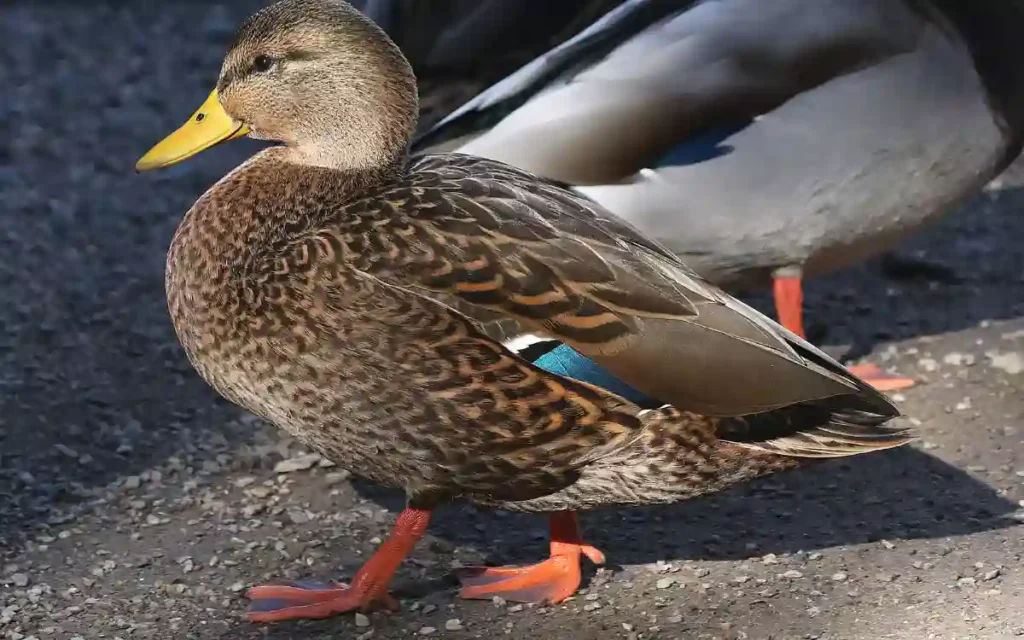
Closely resembling a female Mallard, the Mexican Duck is slightly darker overall and lacks the crisp facial markings of its look-alike. This species is native to the southwestern U.S. and northern Mexico, with a stable population in Texas.
Often found in pairs or small groups, Mexican Ducks quietly forage in marshes and shallow ponds. Their vocalizations are classic “quack” sounds, though softer than the Mallard’s.
- Habitat: Marshes, ponds, irrigation ditches
- Nesting: Ground nests in tall grass or brush
- Eggs: 4–9 per clutch
- Wingspan: 32.3 – 37.4 in (82 – 95 cm)
- Length: 45–55 cm
- Weight: 1.9 – 2.7 lbs
27. Snow Goose (Anser caerulescens):
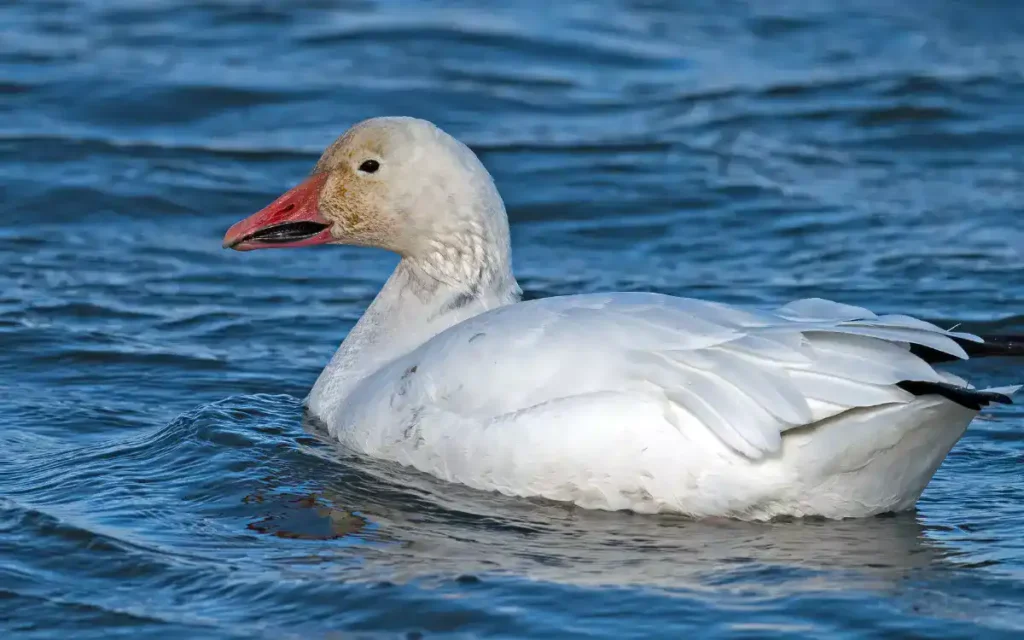
The Snow Goose makes quite the spectacle during winter in Texas, arriving in huge, noisy flocks. These birds are mostly white with black wingtips, though a “blue morph” exists with a gray body and white face.
Their loud honks and bark-like calls can be heard from a distance as they feed on agricultural fields or rest in shallow wetlands.
- Habitat: Coastal marshes, fields, wetlands
- Nesting: Arctic tundra (summer only)
- Eggs: 2–5 per clutch
- Wingspan: 54.3 in (138 cm)
- Length: 27.2–32.7 in (69–83 cm)
- Weight: 56.4–116.4 oz (1.6–3.3 kg)
28. Canada Goose (Branta canadensis):

Familiar and widespread, the Canada Goose is a year-round resident and winter visitor in many parts of Texas. These geese have long black necks, white chinstraps, and loud honking calls that echo through lakes and parks.
They graze on grasses and grains, often foraging in open fields or resting near water. While often seen as urban birds, they are a vital part of Texas’s wetland ecosystems.
- Habitat: Lakes, golf courses, fields, rivers
- Nesting: Ground nests near water or on islands
- Eggs: ~5 per clutch
- Wingspan: 50.0–66.9 in (127–170 cm)
- Length: 29.9–43.3 in (76–110 cm)
- Weight: 105.8–317.5 oz (3–9 kg)
29. White-winged Scoter (Melanitta fusca):
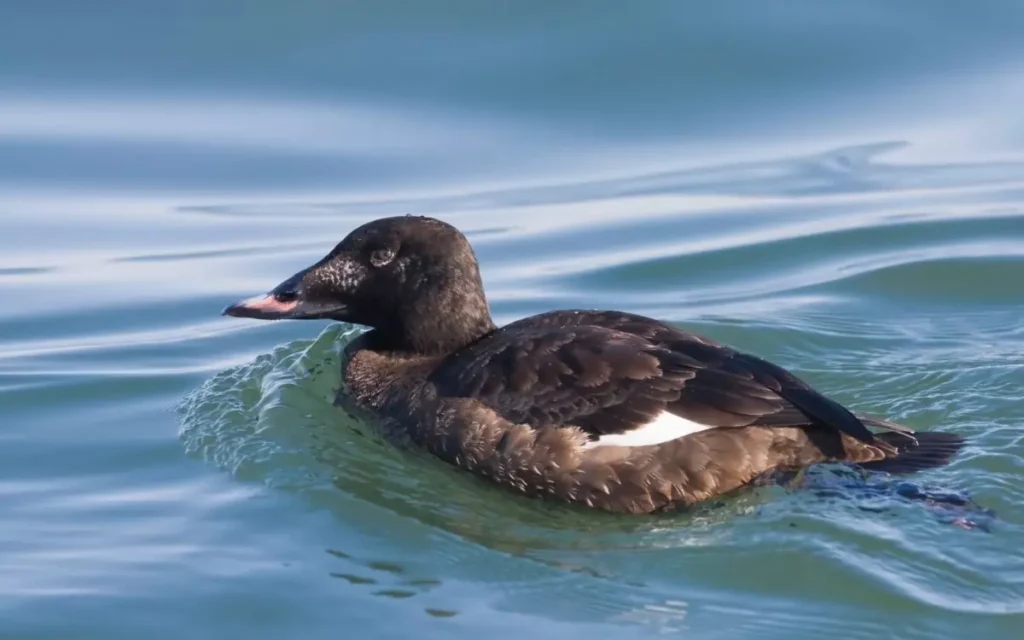
A bulky sea duck with dark plumage and bold white wing patches, the White-winged Scoter is a rare winter visitor along the Texas coast. Males also show a white eye crescent and knob at the base of the bill.
These strong divers hunt for mollusks and crustaceans below the surface and are usually found in open saltwater or large coastal bays.
- Habitat: Coastal waters, large lakes
- Nesting: Ground nests near freshwater (summer only)
- Eggs: 6–16 per clutch
- Wingspan: 31.5 in (80 cm)
- Length: 18.9–22.8 in (48–58 cm)
- Weight: 33.5–63.5 oz (950–1800 g)
Read also:
15 Blue Colored Birds of Texas Identification
30. Pied-billed Grebe (Podilymbus podiceps):
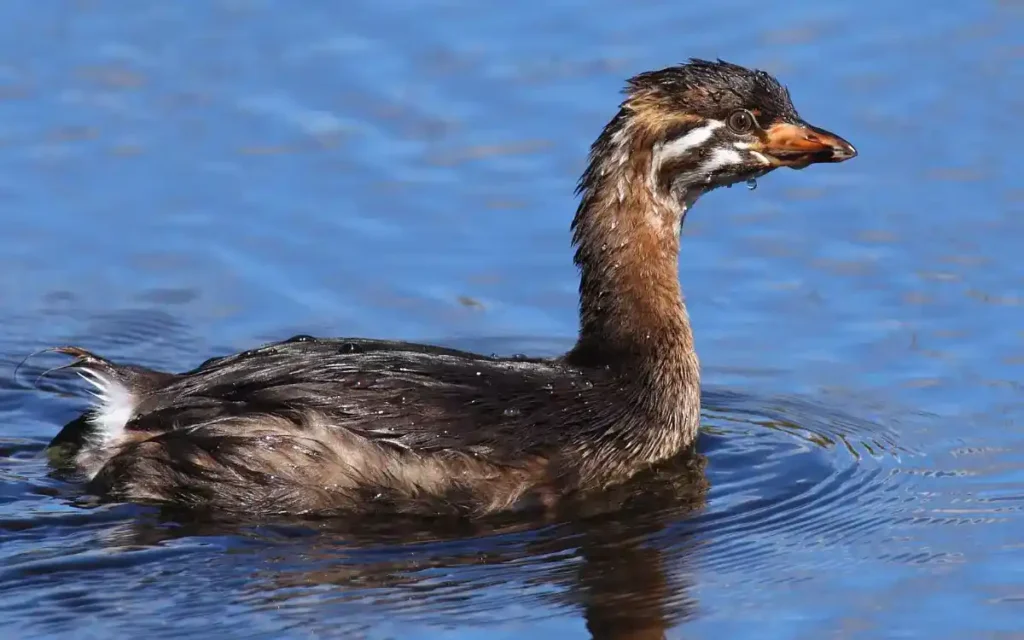
Though not technically a duck, the Pied-billed Grebe is a common sight on Texas ponds and lakes. It’s a chunky waterbird with a short, thick bill marked by a black ring during breeding season.
These excellent divers are shy and often sink below the water rather than fly. Their call, a series of chuckling or gulping notes, is unique and carries over calm water.
- Habitat: Marshes, ponds, lakes, slow rivers
- Nesting: Floating nests in reeds or cattails
- Eggs: 4–10 per clutch
- Wingspan: 17.7–24.4 in (45–62 cm)
- Length: 11.8–15.0 in (30–38 cm)
- Weight: 8.9–20.0 oz (253–568 g)
31. Black Scoter (Melanitta americana):

One of the few all-black ducks, the male Black Scoter has a bright yellow knob on its bill that makes it stand out. Females are dark brown with paler cheeks. These sea ducks are rare winter visitors to the Texas coast.
They feed mostly on mollusks and shellfish and are usually found in deeper coastal waters rather than inland lakes.
- Habitat: Coastal bays, offshore waters
- Nesting: Ground nest near Arctic lakes (not in Texas)
- Eggs: 5–9 per clutch
- Wingspan: 27.6–28.4 in (70–72 cm)
- Length: 16.9–19.3 in (43–49 cm)
- Weight: 30.4–38.8 oz (862–1100 g)
32. Masked Duck (Nomonyx dominicus):

Small, secretive, and hard to spot, the Masked Duck is a tropical species occasionally seen in south Texas. Males in breeding plumage have a rich chestnut body and a blue bill, while females and non-breeding males are cryptic and mottled.
They prefer dense marshes with floating vegetation and are more often heard than seen.
- Habitat: Densely vegetated freshwater marshes
- Nesting: Concealed nests above water in reeds
- Eggs: 7–10 per clutch
- Wingspan: 28–39 in
- Length: ~13.6 cm
- Weight: 363 g (12.8 oz)
33. Common Loon (Gavia immer):
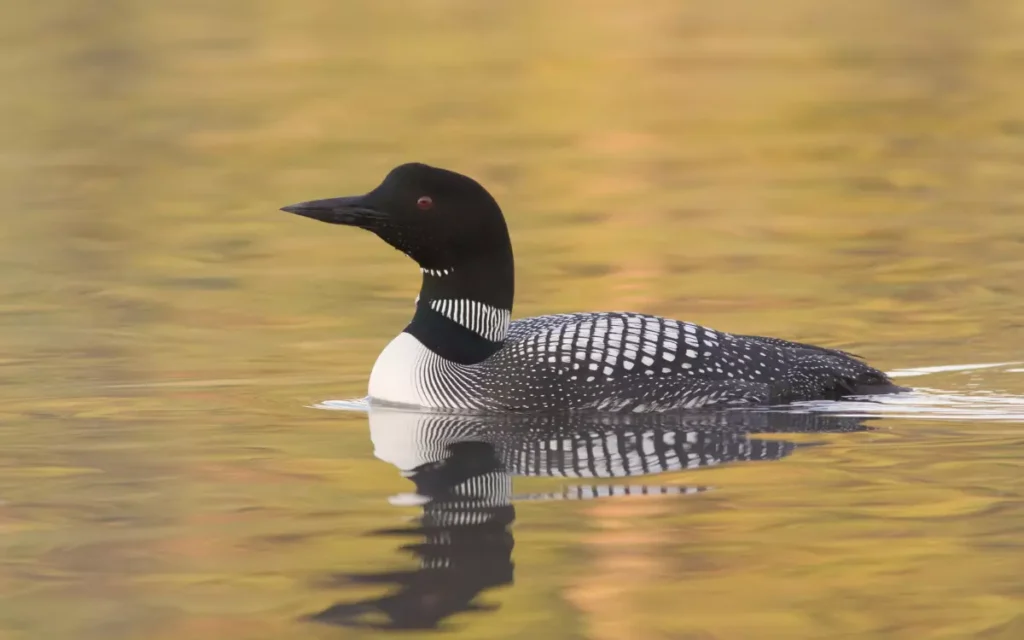
While loons are not ducks, the Common Loon is sometimes seen on large Texas lakes during winter migration. Known for their eerie, echoing calls up north, they’re silent in winter plumage but remain striking with dagger-like bills and crisp diving abilities.
They dive for fish and stay underwater for long periods. In Texas, they’re usually found alone or in small groups.
- Habitat: Large lakes, reservoirs, coastal bays
- Nesting: Arctic lakes (summer only)
- Eggs: 2 per clutch
- Wingspan: 40.9–51.6 in (104–131 cm)
- Length: 26.0–35.8 in (66–91 cm)
- Weight: 88.2–215.2 oz (2.5–6.1 kg)
34. Double-crested Cormorant (Phalacrocorax auritus):
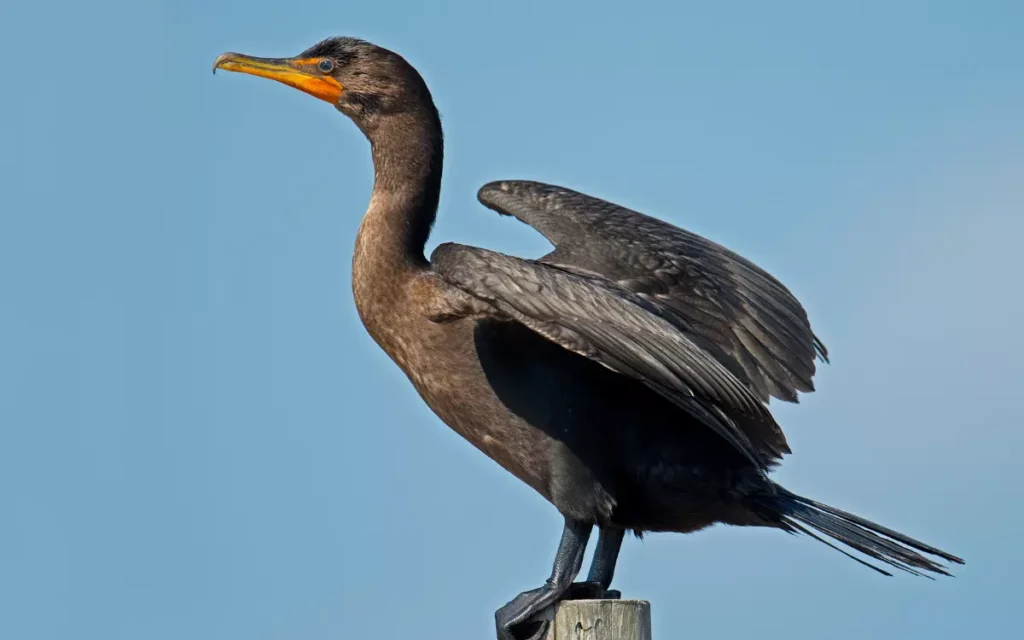
This large, dark waterbird is not a duck, but it’s commonly seen across Texas diving for fish. Cormorants sit low in the water and dry their wings by perching with them spread wide open.
They’re year-round residents, especially common near lakes, rivers, and along the coast.
- Habitat: Lakes, rivers, bays, estuaries
- Nesting: Tree or ground colonies
- Eggs: 2–7 per clutch
- Wingspan: 44.9–48.4 in (114–123 cm)
- Length: 27.6–35.4 in (70–90 cm)
- Weight: 42.3–88.2 oz (1200–2500 g)
35. American Coot (Fulica americana)

Though duck-like in shape, the American Coot is part of a different bird family. They have a rounded dark body, red eyes, and a white beak. Instead of waddling, they walk easily on land and swim with lobed toes.
Coots are noisy, common, and often seen in big flocks across Texas year-round.
- Habitat: Lakes, ponds, marshes
- Nesting: Floating nests in reeds or cattails
- Eggs: 6–12 per clutch
- Wingspan: 23.0–25.0 in (58.4–63.5 cm)
- Length: 15.5–16.9 in (39.4–42.9 cm)
- Weight: 21.2–24.7 oz (600–700 g)
36. Greater White-fronted Goose (Anser albifrons):
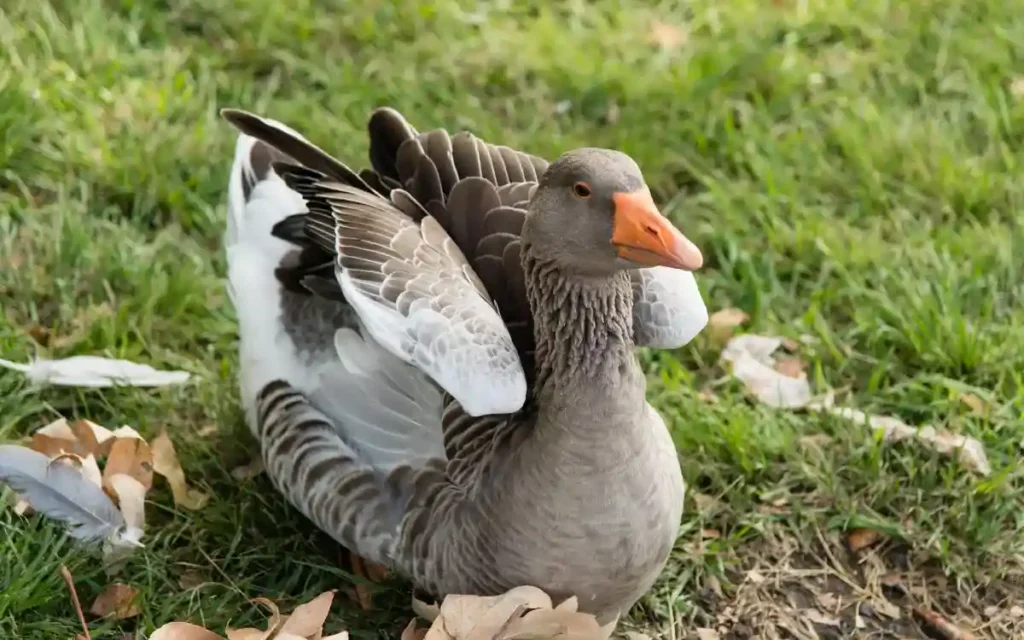
This goose is best known for its white “face” at the base of the bill and speckled belly. It’s a frequent winter visitor to Texas, often found in flocks feeding in agricultural fields alongside other geese.
Their calls are high-pitched yelps and honks, often heard in chorus.
- Habitat: Fields, marshes, wetlands
- Nesting: Arctic tundra (summer)
- Eggs: 4–7 per clutch
- Wingspan: 53.1 in (135 cm)
- Length: 25.2–31.9 in (64–81 cm)
- Weight: 68.8–116.8 oz (1.9–3.3 kg)
37. Western Grebe (Aechmophorus occidentalis):
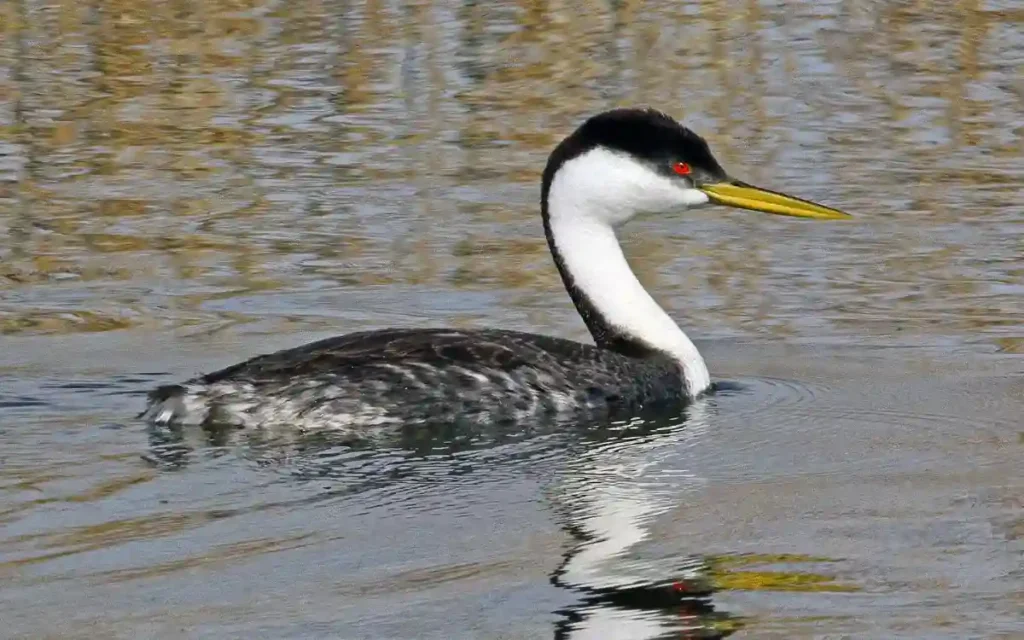
Slender and striking, the Western Grebe is known for its elegant black-and-white contrast and long neck. Though rare, they can be spotted in Texas during winter.
They’re most famous for their synchronized courtship dances, which are seldom seen outside their breeding range. Their calls are long, trilling cries.
- Habitat: Large lakes, reservoirs
- Nesting: Floating vegetation beds (mainly west U.S.)
- Eggs: 2 per clutch
- Wingspan: 22.8–25.2 in (58–64 cm)
- Length: 21.6–29.5 in (55–75 cm)
- Weight: 40.1–64.4 oz (1.1–1.8 kg)
38. Ross’s Goose (Anser rossii):

Smaller and rounder than the Snow Goose, Ross’s Goose often joins large flocks of its larger cousin in Texas during winter. It has a short neck, stubby bill, and a more gentle, high-pitched honk.
Watch for them in the Panhandle and along the coast, especially in open fields.
- Habitat: Agricultural fields, marshes
- Nesting: Arctic tundra (summer)
- Eggs: 4 per clutch
- Wingspan: 44.5–45.7 in (113–116 cm)
- Length: 23.2–25.2 in (59–64 cm)
- Weight: 42.3–55.3 oz (1.2–1.6 kg)
39. Black-necked Grebe (Podiceps nigricollis):

Also called the Eared Grebe, the Black-necked Grebe is a small, dark waterbird with golden cheek tufts during breeding season. In winter, they’re black and gray with red eyes and a short bill.
They’re uncommon in Texas but may be seen in wetlands during migration.
- Habitat: Shallow lakes, brackish lagoons
- Nesting: Floating nests in marshes
- Eggs: 3–4 per clutch
- Wingspan: 95–120 in (likely an error; typical ~20–22 in)
- Length: ~11–13 in
- Weight: 9.3–15.9 oz
40. American White Pelican (Pelecanus erythrorrhynchos):
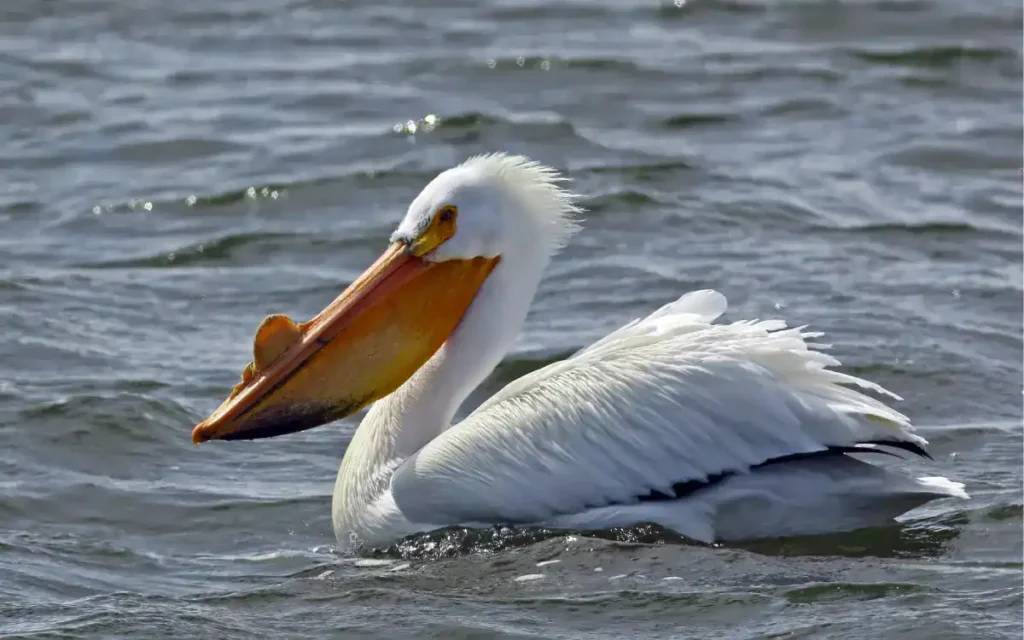
Enormous and graceful, the American White Pelican is hard to miss. These massive birds fly in V-formations and forage cooperatively by swimming in groups to herd fish.
They’re winter visitors across much of Texas and breed in northern colonies during summer.
- Habitat: Large lakes, reservoirs, coastal lagoons
- Nesting: Ground colonies on remote islands
- Eggs: 2–4 per clutch
- Wingspan: 96.1–114.2 in (244–290 cm)
- Length: 50.0–65.0 in (127–165 cm)
- Weight: 158.7–317.5 oz (4.5–9 kg)
41. Brown Pelican (Pelecanus occidentalis):

Texas’s coastal icon, the Brown Pelican plunges dramatically into the ocean to snatch fish. These big birds have long bills, pouchy throats, and fly in elegant lines just above the water.
They’re found year-round along the Gulf Coast, often resting on pilings or docks.
- Habitat: Coastal bays, beaches, harbors
- Nesting: Ground colonies on isolated islands
- Eggs: 3 per clutch
- Wingspan: 78.7 in (200 cm)
- Length: 39.4–53.9 in (100–137 cm)
- Weight: 70.5–176.4 oz (2–5 kg)
FAQs
What types of ducks live in Texas year-round?
Several duck species are permanent residents in Texas, including the Mottled Duck, Black-bellied Whistling Duck, Wood Duck, and Muscovy Duck. These ducks can be seen throughout the year, especially in marshes, forested ponds, and along the Gulf Coast.
When is the best time to see ducks in Texas?
Winter (November to February) is prime duck-watching season in Texas. Many species migrate south and spend the winter in Texas wetlands, including Northern Pintails, Redheads, American Wigeons, and Canvasbacks.
What are the most common ducks in Texas?
Commonly seen ducks include the Mallard, Blue-winged Teal, Gadwall, Green-winged Teal, and American Coot. These species are found across lakes, ponds, flooded fields, and marshes across the state.
Where can I go birdwatching for ducks in Texas?
Top duck-watching spots include:
- Anahuac National Wildlife Refuge
- Hagerman NWR
- Aransas NWR
- Caddo Lake
- Texas coastlines and rice fields during migration These areas offer shallow water, native vegetation, and minimal human disturbance—perfect for waterfowl.
How can I tell a diving duck from a dabbling duck?
Dabbling ducks (like Mallards and Teals) feed by tipping forward on the surface of the water. Diving ducks (like Redheads and Buffleheads) plunge completely underwater to forage. You can also tell by their shape: diving ducks tend to sit lower in the water and have compact bodies.
Are ducks protected in Texas?
Yes, nearly all duck species are protected under the Migratory Bird Treaty Act. Hunting is legal only during set seasons with proper licenses, and many areas offer protected wetlands for observation only.
Can you attract wild ducks to your backyard pond in Texas?
You can, if the pond is quiet, has natural edges, and includes native aquatic plants. Avoid feeding ducks bread—offer cracked corn or birdseed if you choose to feed them. Nest boxes for Wood Ducks can also increase sightings in wooded areas.
What are those large white ducks I see in Texas parks?
They’re often Muscovy Ducks or domestic Mallard hybrids. While they resemble wild ducks, many are feral or semi-domesticated and often congregate near people for food.


